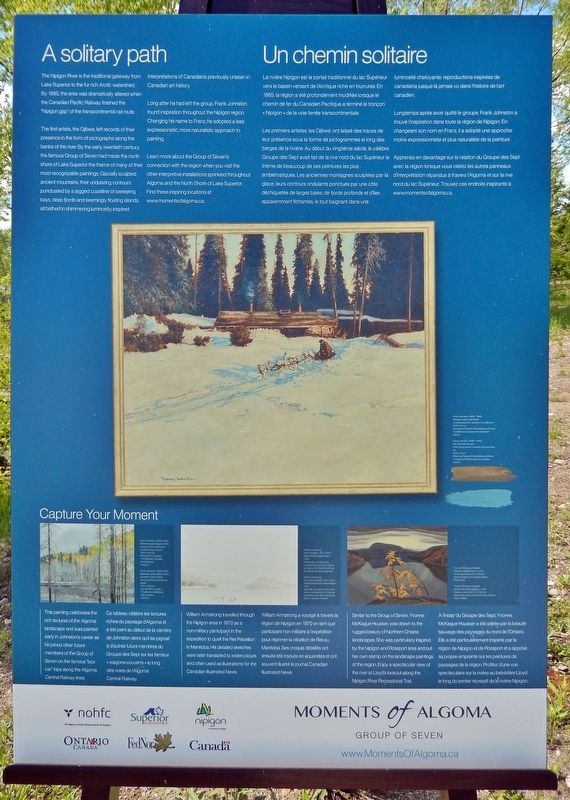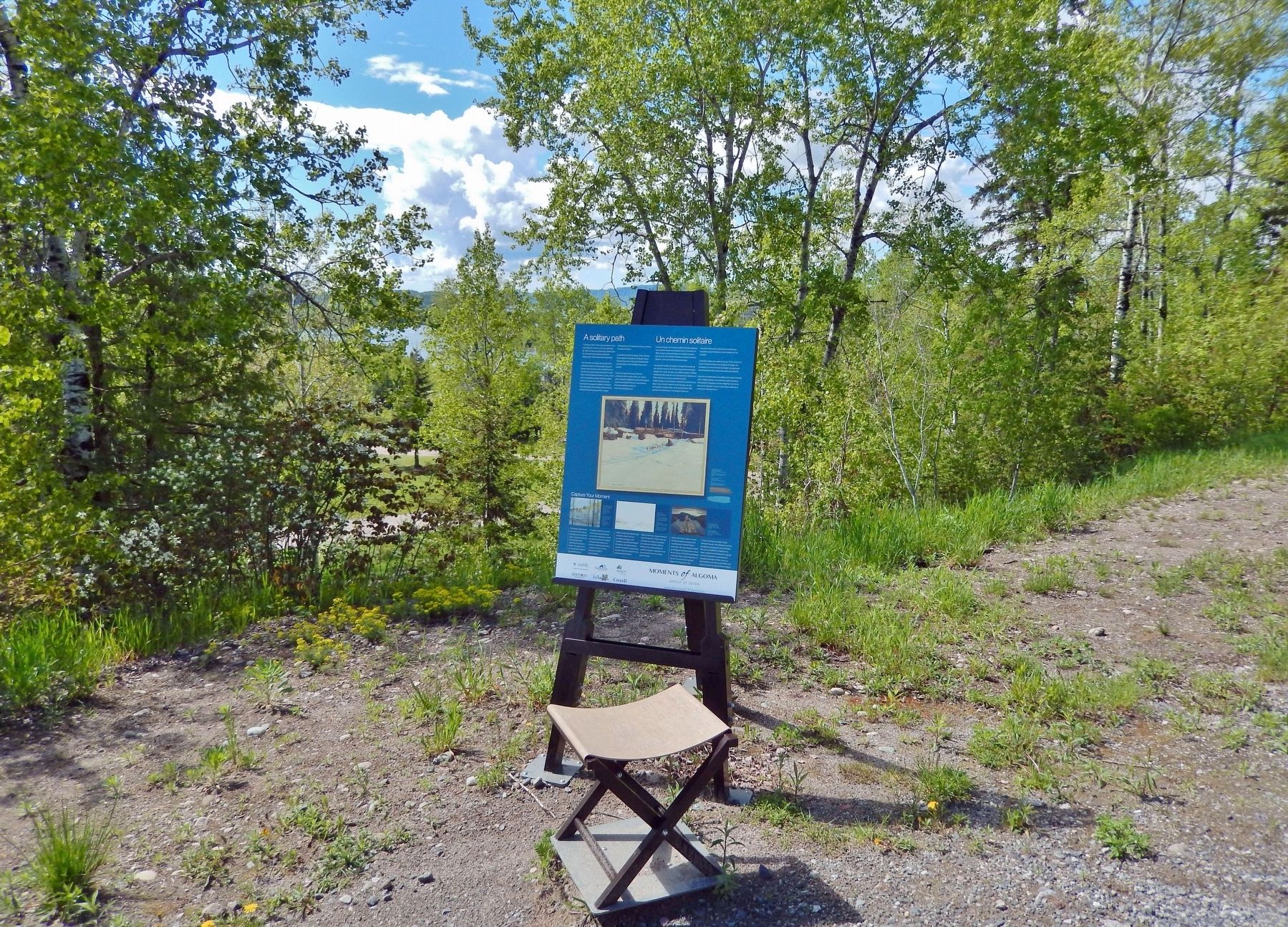Nipigon in Thunder Bay District, Ontario — Central Canada (North America)
A solitary path / Un chemin solitaire
The Nipigon River is the traditional gateway from Lake Superior to the fur rich Arctic watershed. By 1885, the area was dramatically altered when the Canadian Pacific Railway finished the "Nipigon gap" of the transcontinental rail route.
The first artists, the Ojibwe, left records of their presence in the form of pictographs along the banks of the river. By the early twentieth century, the famous Group of Seven had made the north shore of Lake Superior the theme of many of their most recognizable paintings. Glacially sculpted ancient mountains, their undulating contours punctuated by a jagged coastline of sweeping bays, deep fjords and seemingly floating islands, all bathed in shimmering luminosity, inspired interpretations of Canadiana previously unseen in Canadian art history.
Long after he had left the group, Frank Johnston found inspiration throughout the Nipigon region. Changing his name to Franz, he adopted a less expressionistic, more naturalistic approach to painting.
Learn more about the Group of Seven's connection with the region when you visit the other interpretive installations sprinkled throughout Algoma and the North Shore of Lake Superior. Find these inspiring locations at www.momentsofalgoma.ca.
Drowned Land, Algoma, 1918
This painting celebrates the rich textures of the Algoma landscape and was painted early in Johnston's career as he joined other future members of the Group of Seven on the famous “box car” trips along the Algoma Central Railway lines.
Mouth of the Nipigon River, 1901
William Armstrong travelled through the Nipigon area in 1870 as a non-military participant in the expedition to quell the Riel Rebellion in Manitoba. His detailed sketches were later translated to watercolours and often used as illustrations for the Canadian Illustrated News.
Mouth of the Nipigon River, 1901
Similar to the Group of Seven, Yvonne McKague Housser, was drawn to the rugged beauty of Northern Ontario landscapes. She was particularly inspired by the Nipigon and Rossport area and put her own stamp on the landscape paintings of the region. Enjoy a spectacular view of the river at Lloyd's lookout along the Nipigon River Recreational Trail.
La rivière Nipigon est le portail traditionnel du lac Supérieur vers le bassin versant de l'Arctique riche en fourrures. En 1885, la région a été profondément
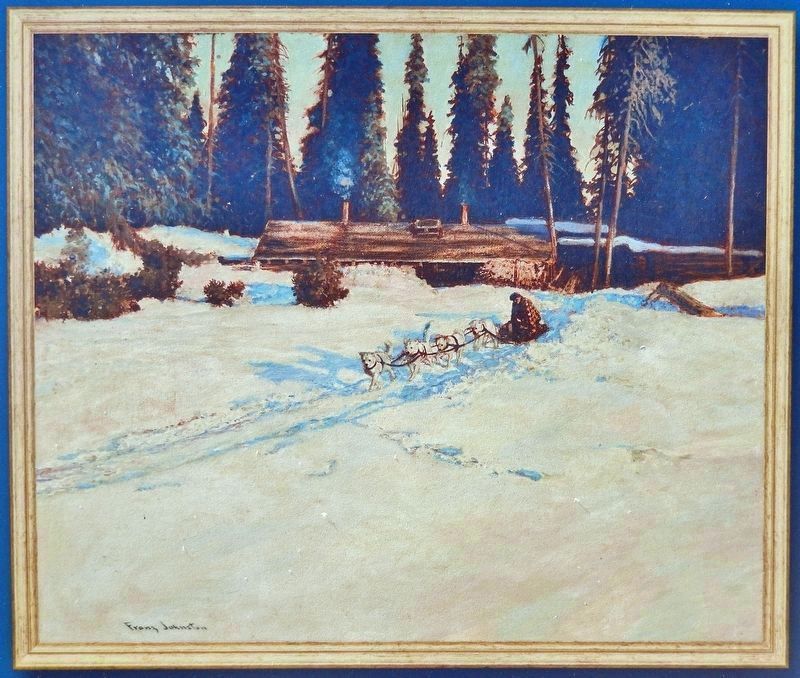
©McMichael Canadian Art Collection
2. Marker detail: Onaman Lake, Late March /
Lac Onamàn, fin mars
Lac Onamàn, fin mars
Frank Johnston (1888-1949)
Onaman Lake, Late March
oil with gouache or tempura on hardboard
50.8 x 61 cm
Donated by Roberta Fuller, Bethany, Ontario
©McMichael Canadian Art Collection
2004.6———————— Frank Johnston (1888-1949)
Lac Onamàn, fin mars
Huile à la gouache ou tempéra sur panneau dur
50,8 x 61 cm
Offert par Roberta Fuller, Bethany, Ontario
©Collection McMichael d'art canadien
2004.6
Onaman Lake, Late March
oil with gouache or tempura on hardboard
50.8 x 61 cm
Donated by Roberta Fuller, Bethany, Ontario
©McMichael Canadian Art Collection
2004.6
Lac Onamàn, fin mars
Huile à la gouache ou tempéra sur panneau dur
50,8 x 61 cm
Offert par Roberta Fuller, Bethany, Ontario
©Collection McMichael d'art canadien
2004.6
Les premiers artistes, les Ojibwé, ont laissé des traces de leur présence sous la forme de pictogrammes le long des berges de la rivière. Au début du vingtième siècle, le célèbre Groupe des Sept avait fait de la rive nord du lac Supérieur le thème de beaucoup de ses peintures les plus emblématiques. Les anciennes montagnes sculptées par la glace, leurs contours ondulants ponctués par une côte déchiquetée de larges baies, de fjords profonds et d'îles apparemment flottantes, le tout baignant dans une luminosité chatoyante, reproductions inspirées de canadiana jusque-là jamais vu dans l'histoire de l'art canadien.
Longtemps après avoir quitté le groupe, Frank Johnston a trouvé l'inspiration dans toute la région de Nipigon. En changeant son nom en Franz, il a adopté une approche moins expressionniste et plus naturaliste de la peinture.
Apprenez-en davantage sur la relation du Groupe des Sept avec la région lorsque vous visitez les autres panneaux d'interprétation répandus à travers l'Algoma et sur la rive nord du lac Supérieur. Trouvez ces endroits inspirants à www.momentsofalgoma.ca.
Drowned Land, Algoma, 1918
Ce tableau célèbre les textures riches du paysage d'Algoma et a été peint au début de la carrière de
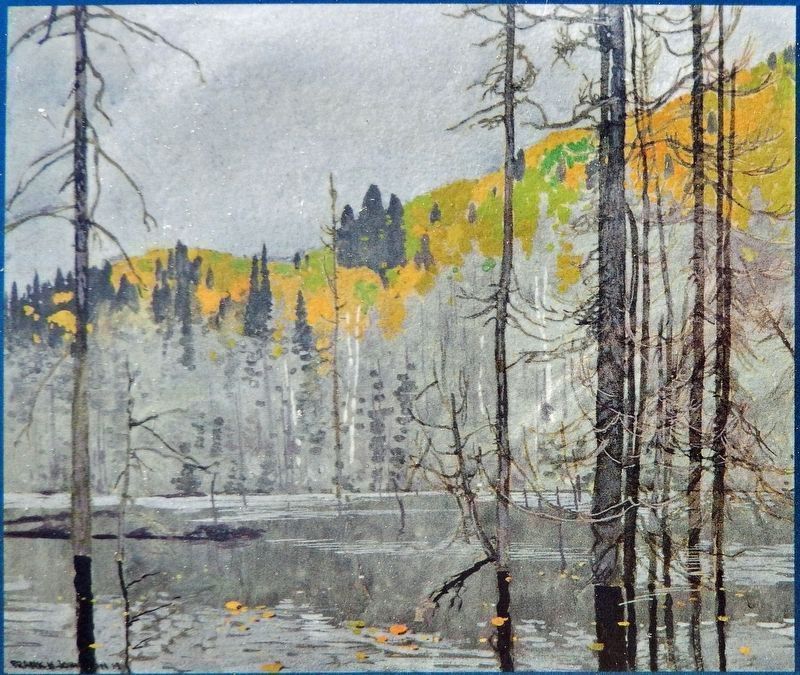
©McMichael Canadian Art Collection
3. Marker detail: Drowned Land, Algoma, 1918
Frank Johnston (1888-1949)
Drowned Land, Algoma, 1918
gouache with watercolour underdrawing on paper
45.9 x 54.8 cm
Gift of Mr. R.A. Laidlaw
©McMichael Canadian Art Collection
1966.15.1———————— Frank Johnston (1888-1949)
Drowned Land, Algoma, 1918
gouache avec le dessin sous-jacent en aquarelle sur papier
45,9 x 54,8 cm
Don de M.R.A. Laidlaw
©Collection McMichael d'art canadien
1966.15.1
Drowned Land, Algoma, 1918
gouache with watercolour underdrawing on paper
45.9 x 54.8 cm
Gift of Mr. R.A. Laidlaw
©McMichael Canadian Art Collection
1966.15.1
Drowned Land, Algoma, 1918
gouache avec le dessin sous-jacent en aquarelle sur papier
45,9 x 54,8 cm
Don de M.R.A. Laidlaw
©Collection McMichael d'art canadien
1966.15.1
Embouchure de la rivière Nipigon, 1901
William Armstrong a voyagé à travers la région de Nipigon en 1870 en tant que participant non militaire à l'expédition pour réprimer la rébellion de Riel au Manitoba. Ses croquis détaillés ont ensuite été traduits en aquarelles et ont souvent illustré le journal Canadian Illustrated News.
Le soir à la rivière Nipigon, v. 1942
À l'instar du Groupe des Sept, Yvonne McKague Housser a été attirée par la beauté sauvage des paysages du nord de l'Ontario. Elle a été particulièrement inspirée par la région de Nipigon et de Rossport et a apposé sa propre empreinte sur les peintures de paysages de la région. Profitez d'une vue spectaculaire sur la rivière au belvédère Lloyd le long du sentier récréatif de la rivière Nipigon.
Erected by Moments of Algoma.
Topics. This historical marker is listed in these topic lists: Arts, Letters, Music • Native Americans • Waterways & Vessels. A significant historical year for this entry is 1885.
Location. 49° 1.014′ N, 88° 15.455′ W. Marker is in Nipigon, Ontario, in Thunder Bay District. Marker is on Railway Street
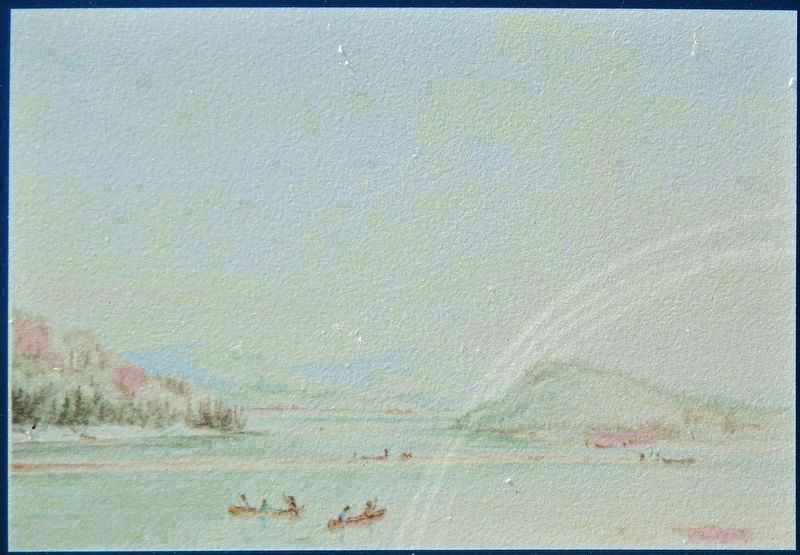
Courtesy Art Gallery of Algoma/Sault Ste. Marie, collection Hamilton
4. Marker detail: Mouth of the Nipigon River, 1901/
Embouchure de la rivière Nipigon
Embouchure de la rivière Nipigon
William Armstrong (Irish Canadien, 1822-1914)
Mouth of the Nipigon River, 1901
Watercolour on paper
On long-term loan to the Art Gallery of Algoma
from the City of Sault Ste. Marie, Hamilton Collection———————— William Armstrong (Canadien Irlandais, 1822-1914)
Embouchure de la rivière Nipigon, 1901
Aquarelle sur Papier prêt à long terme à la Galerie d’art d’Algoma provenant de la ville de Sault Ste. Marie, collection Hamilton
Mouth of the Nipigon River, 1901
Watercolour on paper
On long-term loan to the Art Gallery of Algoma
from the City of Sault Ste. Marie, Hamilton Collection
Embouchure de la rivière Nipigon, 1901
Aquarelle sur Papier prêt à long terme à la Galerie d’art d’Algoma provenant de la ville de Sault Ste. Marie, collection Hamilton
Other nearby markers. At least 8 other markers are within walking distance of this marker. The Old Nipigon CP Railway Station (approx. 0.4 kilometers away); Lest We Forget (approx. half a kilometer away); In Tribute to John Salo (approx. half a kilometer away); Nipigon Service Garage / Palace Theatre (approx. half a kilometer away); The Taylor House (approx. half a kilometer away); The Nipigon River Drives (approx. half a kilometer away); Consolidated School (approx. half a kilometer away); Consumers Co-op Store (approx. 0.6 kilometers away). Touch for a list and map of all markers in Nipigon.
Also see . . .
1. Frank Johnston. Excerpt:
Francis Hans Johnston was a Canadian artist associated with the Group of Seven. Although an original member of the Group, Johnston's association was brief. He did take part in the Group's first exhibition of 1920, but by 1921 he had left Toronto to become Principal at the Winnipeg School of Art. His landscape paintings became very full of images reflected on water. In 1927, Johnston changed his name to the more exotic title of `Franz' Johnston. He painted over 250 paintings in his entire career.
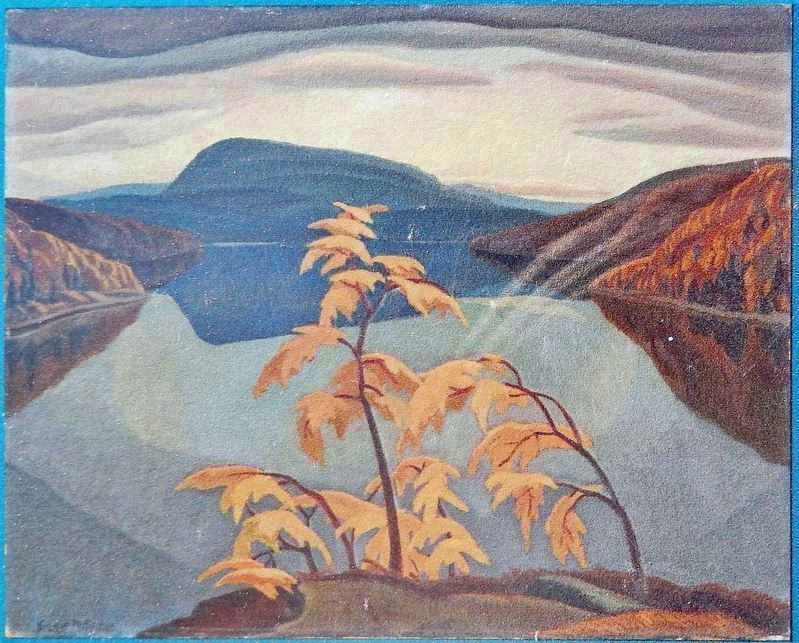
Courtesy National Gallery of Canada, Ottawa
5. Marker detail: Evening, Nipigon River, c.1942/
Le soir à la rivière Nipigon, v.1942
Le soir à la rivière Nipigon, v.1942
Yvonne McKague Housser
Evening, Nipigon River, c. 1942
Oil on paperboard, 61 x 76.2 cm
National Gallery of Canada, Ottawa
Photo: NGC———————— Yvonne McKague Housser
Le soir à la rivière Nipigon, v. 1942
Huile sur carton fort, 61 x 76.2 cm
Musée des beaux-arts du Canada, Ottawa
Photo : MBAC
Evening, Nipigon River, c. 1942
Oil on paperboard, 61 x 76.2 cm
National Gallery of Canada, Ottawa
Photo: NGC
Le soir à la rivière Nipigon, v. 1942
Huile sur carton fort, 61 x 76.2 cm
Musée des beaux-arts du Canada, Ottawa
Photo : MBAC
2. William Armstrong (Wikipedia). Excerpt:
William Armstrong was born in Dublin, Ireland. He studied art in Ireland, then completed an apprenticeship in England with the Midland Railway to become a railway engineer. He immigrated to Canada in 1851, settling in Toronto and began work with the railway. He found a market for his artwork with the illustrated news who covered the events in the colonies. His watercolours of local events and scenes were reproduced as monochrome wood engravings so they could be included in these weekly periodicals.(Submitted on April 12, 2024, by Cosmos Mariner of Cape Canaveral, Florida.)
3. Yvonne McKague Housser (Wikipedia). Excerpt:
A Modernist Canadian painter, and a teacher. She studied at the Ontario College of Art (OCA), Toronto, from 1913 to 1918. In 1923, she first exhibited her work with the Royal Canadian Academy, and in 1924 with the Ontario Society of Artists of which became a member in 1928. McKague also was a founding member of the Canadian Group of Painters in 1933, and the Federation of Canadian Artists in 1941. She was made a full member of the Royal Canadian Academy of Arts in 1951. In 1954, she was one of eighteen Canadian artists commissioned by the Canadian Pacific Railway to paint a mural for the interior of one of the new Park cars entering service on the new Canadian transcontinental train. Each mural depicts a different national or provincial park; Housser's was Sibley Provincial Park. She was the only woman artist who was asked to do a mural.(Submitted on April 12, 2024, by Cosmos Mariner of Cape Canaveral, Florida.)
Credits. This page was last revised on April 12, 2024. It was originally submitted on April 11, 2024, by Cosmos Mariner of Cape Canaveral, Florida. This page has been viewed 49 times since then. Photos: 1, 2, 3, 4, 5, 6. submitted on April 12, 2024, by Cosmos Mariner of Cape Canaveral, Florida.
